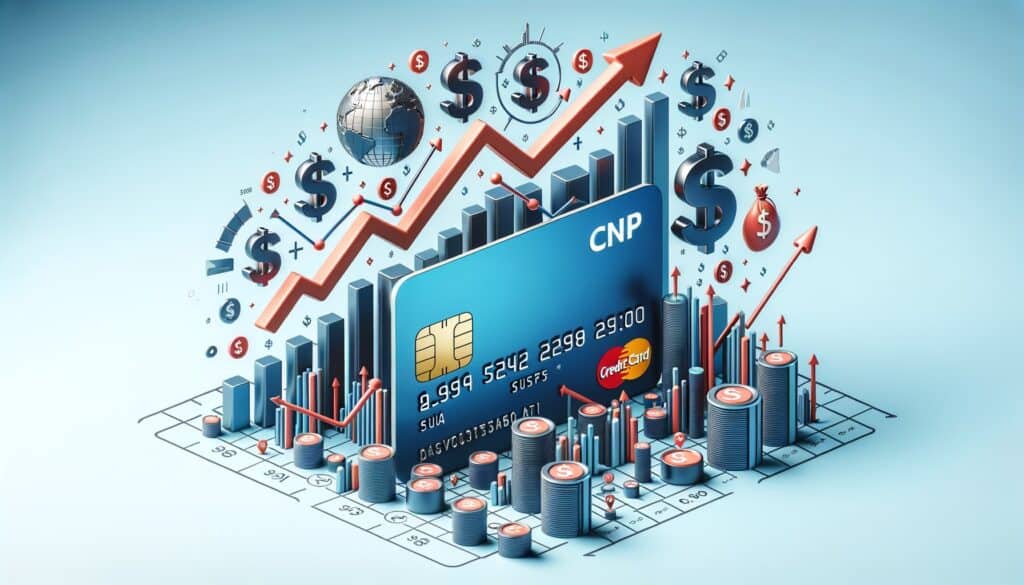
By admin October 10, 2024
In today’s digital age, online shopping has become increasingly popular, allowing consumers to make purchases from the comfort of their own homes. However, with the rise of online transactions comes the need for a secure and efficient payment method. One such method is the card-not-present (CNP) transaction, which refers to any purchase made without physically presenting a payment card to the merchant.
This article will delve into the intricacies of CNP transactions, exploring how they work, the risks associated with them, and why they often come at a higher cost.
How Does a Card-Not-Present Transaction Work?
A card-not-present transaction occurs when a customer provides their payment card details to a merchant through alternative means, such as over the phone, via email, or on an online platform. The merchant then processes the payment using the provided card information. This method is commonly used for online purchases, subscriptions, and recurring payments.
To initiate a CNP transaction, the customer typically provides their card number, expiration date, and CVV code. In some cases, additional information such as the cardholder’s name and billing address may be required for verification purposes. Once the merchant receives the payment details, they transmit the information to a payment processor, who then communicates with the card issuer to authorize the transaction.
The Risks Associated with CNP Transactions

While CNP transactions offer convenience and accessibility, they also come with inherent risks. One of the primary concerns is the potential for fraud. Unlike in-person transactions, where the merchant can physically verify the card and the identity of the customer, CNP transactions rely solely on the information provided by the customer. This opens the door for fraudulent activities, such as stolen card details or identity theft.
Additionally, CNP transactions are susceptible to chargebacks, which occur when a customer disputes a transaction and requests a refund from their card issuer. Chargebacks can be initiated for various reasons, including unauthorized transactions, dissatisfaction with the product or service, or failure to receive the purchased item. Merchants are often held responsible for chargebacks, resulting in financial losses and potential damage to their reputation.
Factors That Contribute to the Higher Cost of CNP Transactions

One of the reasons why CNP transactions tend to be more expensive than traditional card-present transactions is the increased risk associated with them. Merchants and payment processors incur additional costs to mitigate these risks and ensure the security of the transaction. Some of the factors that contribute to the higher cost of CNP transactions include:
- Fraud Prevention Measures: Merchants invest in various fraud prevention tools and technologies to minimize the risk of fraudulent transactions. These measures include address verification systems, card security codes, and fraud detection algorithms. Implementing and maintaining these systems can be costly, adding to the overall cost of CNP transactions.
- Chargeback Management: As mentioned earlier, chargebacks are a significant concern for merchants in CNP transactions. To handle chargebacks efficiently, merchants often employ chargeback management services or software, which help them dispute invalid chargebacks and recover lost funds. These services come at a cost, further increasing the expenses associated with CNP transactions.
- Compliance Requirements: Merchants processing CNP transactions must adhere to strict industry regulations and security standards, such as the Payment Card Industry Data Security Standard (PCI DSS). Compliance with these standards requires regular audits, security assessments, and ongoing maintenance, all of which contribute to the higher cost of CNP transactions.
- Insurance and Liability: Due to the increased risk of fraud and chargebacks, merchants may need to obtain specialized insurance coverage to protect themselves from financial losses. This insurance comes at a premium, adding to the overall cost of CNP transactions.
Payment Processing Fees for CNP Transactions: Explained

In addition to the factors mentioned above, payment processing fees also contribute to the higher cost of CNP transactions. When a merchant processes a payment, they typically pay a fee to the payment processor for facilitating the transaction. This fee covers the costs associated with processing the payment, including authorization, settlement, and security measures.
The exact fee structure for CNP transactions can vary depending on several factors, such as the merchant’s industry, transaction volume, and the payment processor they choose. However, there are some common types of fees that merchants can expect to encounter:
- Interchange Fees: Interchange fees are charged by the card networks (e.g., Visa, Mastercard) and are typically the largest component of payment processing fees. These fees are set by the card networks and vary based on factors such as the type of card used (debit, credit, rewards), the transaction amount, and the merchant’s industry. Interchange fees are generally higher for CNP transactions compared to card-present transactions due to the increased risk involved.
- Assessment Fees: Assessment fees are charged by the card networks to cover their operational costs and are typically a percentage of the transaction value. These fees are relatively consistent across different payment processors and are not directly influenced by the nature of the transaction.
- Payment Gateway Fees: Payment gateways act as intermediaries between the merchant’s website or application and the payment processor. They provide the necessary infrastructure to securely transmit payment data. Payment gateway fees are charged by the gateway provider and can be a flat fee per transaction or a monthly subscription fee.
- Markup Fees: Payment processors often charge a markup fee on top of the interchange and assessment fees. This fee is the primary source of revenue for the payment processor and covers their operational costs, customer support, and profit margin. Markup fees can vary significantly between processors, so it’s essential for merchants to compare rates and negotiate favorable terms.
Fraud Prevention Measures for CNP Transactions
Given the increased risk of fraud in CNP transactions, merchants must implement robust fraud prevention measures to protect themselves and their customers. These measures aim to identify and prevent fraudulent transactions before they occur, reducing the financial losses associated with chargebacks and unauthorized purchases. Some common fraud prevention techniques for CNP transactions include:
- Address Verification System (AVS): AVS is a security feature that compares the billing address provided by the customer with the address on file with the card issuer. By verifying the address, merchants can detect potential discrepancies and flag suspicious transactions for further review.
- Card Security Codes: Card security codes, such as CVV or CVC, are three or four-digit numbers printed on payment cards. Merchants often require customers to provide these codes during CNP transactions to verify that the customer has physical possession of the card. This additional layer of security helps prevent fraudulent transactions by ensuring that the card details are not obtained through unauthorized means.
- Fraud Detection Algorithms: Many payment processors and fraud prevention services utilize sophisticated algorithms to analyze transaction data and identify patterns indicative of fraudulent activity. These algorithms consider various factors, such as transaction velocity, IP geolocation, device fingerprinting, and historical transaction data, to assess the risk level of each transaction. If a transaction is flagged as potentially fraudulent, additional verification steps may be required before the payment is processed.
- Two-Factor Authentication (2FA): Two-factor authentication adds an extra layer of security by requiring customers to provide additional verification, such as a one-time password sent to their mobile device, in addition to their payment card details. This method ensures that even if a fraudster obtains the card details, they would still need access to the customer’s mobile device to complete the transaction.
The Role of Technology in Securing CNP Transactions
Advancements in technology have played a crucial role in enhancing the security of CNP transactions. Various tools and technologies have been developed to protect sensitive payment data and prevent unauthorized access. Some key technologies used to secure CNP transactions include:
- Tokenization: Tokenization is a process that replaces sensitive payment card data with a unique identifier, known as a token. This token is used for transaction processing, while the actual card details are securely stored in a token vault. By tokenizing the data, merchants can significantly reduce the risk of cardholder data theft, as the tokens are useless to potential fraudsters.
- Encryption: Encryption is the process of converting sensitive data into an unreadable format using cryptographic algorithms. When a customer enters their payment card details during a CNP transaction, the data is encrypted before being transmitted to the payment processor. Encryption ensures that even if the data is intercepted, it cannot be deciphered without the encryption key.
- EMV 3-D Secure: EMV 3-D Secure is a protocol developed by the major card networks to enhance the security of CNP transactions. It adds an additional layer of authentication by requiring customers to provide a one-time password or biometric verification during the checkout process. This protocol helps reduce the risk of fraudulent transactions by verifying the identity of the cardholder.
- Machine Learning and Artificial Intelligence: Machine learning and artificial intelligence (AI) technologies are increasingly being used to detect and prevent fraud in real-time. These technologies analyze vast amounts of transaction data and identify patterns that may indicate fraudulent activity. By continuously learning from new data, machine learning algorithms can adapt and improve their fraud detection capabilities over time.
Strategies to Reduce the Cost of CNP Transactions
While CNP transactions may come at a higher cost compared to card-present transactions, there are strategies that merchants can employ to reduce these costs. By optimizing their payment processing setup and implementing cost-saving measures, merchants can minimize the impact on their bottom line. Some strategies to consider include:
- Negotiate Lower Processing Rates: When selecting a payment processor, merchants should compare rates from multiple providers and negotiate favorable terms. Payment processors are often willing to offer competitive rates to attract new clients or retain existing ones. By leveraging their transaction volume and demonstrating a strong credit history, merchants can negotiate lower processing rates, reducing the overall cost of CNP transactions.
- Optimize Interchange Fees: Interchange fees, set by the card networks, are a significant component of payment processing costs. Merchants can optimize their interchange fees by ensuring they qualify for the lowest possible rates. This can be achieved by implementing best practices, such as obtaining address verification, capturing additional customer data, and settling transactions promptly.
- Implement Fraud Prevention Measures: While fraud prevention measures may add to the cost of CNP transactions, they can ultimately save merchants money by reducing chargebacks and fraudulent transactions. By investing in robust fraud prevention tools and technologies, merchants can minimize their financial losses and maintain a secure payment environment.
- Streamline Chargeback Management: Efficient chargeback management can help merchants recover lost funds and reduce the impact of chargebacks on their bottom line. By promptly responding to chargeback notifications, providing compelling evidence, and disputing invalid chargebacks, merchants can increase their chances of winning disputes and recovering funds.
- Leverage Payment Gateway Features: Payment gateways often offer additional features and services that can help merchants optimize their payment processing setup. For example, some gateways provide fraud prevention tools, chargeback management services, and reporting capabilities. By leveraging these features, merchants can streamline their operations and reduce the need for third-party solutions, potentially saving on costs.
Frequently Asked Questions (FAQs)
Q.1: What is the difference between a card-present and a card-not-present transaction?
A card-present transaction occurs when a customer physically presents their payment card to the merchant, such as in a retail store. In contrast, a card-not-present transaction refers to any purchase made without physically presenting the card, such as online or over the phone.
Q.2: Why do CNP transactions cost more than card-present transactions?
CNP transactions often come at a higher cost due to the increased risk of fraud and chargebacks. Merchants and payment processors incur additional expenses to implement fraud prevention measures, manage chargebacks, and maintain compliance with industry regulations.
Q.3: How can merchants protect themselves from fraud in CNP transactions?
Merchants can protect themselves from fraud in CNP transactions by implementing robust fraud prevention measures, such as address verification systems, card security codes, and fraud detection algorithms. Additionally, merchants should stay updated on the latest security technologies and industry best practices.
Q.4: What are chargebacks, and why are they a concern for merchants in CNP transactions?
Chargebacks occur when a customer disputes a transaction and requests a refund from their card issuer. Merchants are often held responsible for chargebacks, resulting in financial losses and potential damage to their reputation. CNP transactions are particularly susceptible to chargebacks due to the lack of physical card verification.
Q.5: How can merchants reduce the cost of CNP transactions?
Merchants can reduce the cost of CNP transactions by negotiating lower processing rates, optimizing interchange fees, implementing fraud prevention measures, streamlining chargeback management, and leveraging payment gateway features. These strategies can help minimize the impact on the merchant’s bottom line.
Conclusion
Card-not-present (CNP) transactions have become an integral part of the modern economy, enabling consumers to make purchases conveniently and securely online. However, the nature of CNP transactions introduces additional risks and costs compared to traditional card-present transactions. Merchants and payment processors must invest in fraud prevention measures, chargeback management, and compliance requirements to ensure the security and integrity of CNP transactions.
While the higher cost of CNP transactions may seem burdensome, merchants can mitigate these expenses by implementing cost-saving strategies and optimizing their payment processing setup. By negotiating lower processing rates, optimizing interchange fees, implementing fraud prevention measures, streamlining chargeback management, and leveraging payment gateway features, merchants can reduce the overall cost of CNP transactions and maintain a secure and efficient payment environment.
As technology continues to advance, it is expected that new tools and techniques will emerge to further enhance the security and affordability of CNP transactions. By staying informed and adapting to these developments, merchants can continue to provide a seamless and secure payment experience for their customers while minimizing costs and risks.